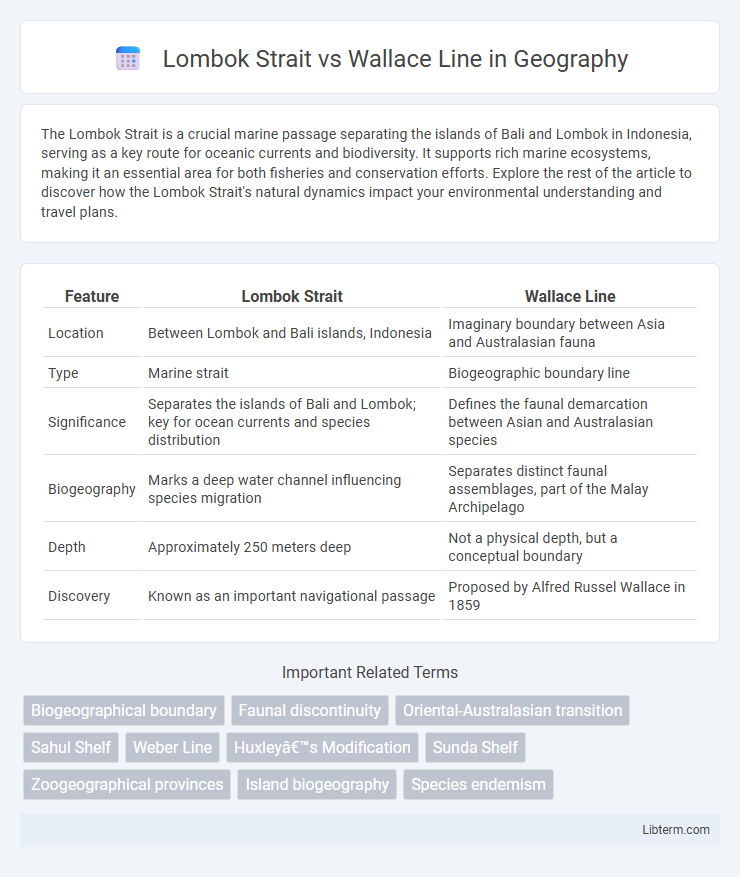The Lombok Strait is a crucial marine passage separating the islands of Bali and Lombok in Indonesia, serving as a key route for oceanic currents and biodiversity. It supports rich marine ecosystems, making it an essential area for both fisheries and conservation efforts. Explore the rest of the article to discover how the Lombok Strait's natural dynamics impact your environmental understanding and travel plans.
Table of Comparison
| Feature | Lombok Strait | Wallace Line |
|---|---|---|
| Location | Between Lombok and Bali islands, Indonesia | Imaginary boundary between Asia and Australasian fauna |
| Type | Marine strait | Biogeographic boundary line |
| Significance | Separates the islands of Bali and Lombok; key for ocean currents and species distribution | Defines the faunal demarcation between Asian and Australasian species |
| Biogeography | Marks a deep water channel influencing species migration | Separates distinct faunal assemblages, part of the Malay Archipelago |
| Depth | Approximately 250 meters deep | Not a physical depth, but a conceptual boundary |
| Discovery | Known as an important navigational passage | Proposed by Alfred Russel Wallace in 1859 |
Introduction to the Lombok Strait
The Lombok Strait serves as a crucial marine passage between the islands of Bali and Lombok in Indonesia, acting as a key biogeographical boundary that separates Asian and Australasian fauna. Positioned east of the Wallace Line, the strait delineates distinct ecological zones, with deepwater channels fostering unique biodiversity and facilitating species migration. Its role in ocean currents and marine life distribution underscores its significance in studies of biogeography and evolutionary biology.
Defining the Wallace Line
The Wallace Line is a biogeographical boundary that runs between the islands of Bali and Lombok in Indonesia, marking a distinct separation between the fauna of Asia and Australasia. It highlights significant differences in species distribution due to deep-water channels that prevented migration during glacial periods, creating unique ecosystems on either side. The Lombok Strait, located near the Wallace Line, serves as this natural divide where Indonesian and Australian species communities distinctly differ.
Geographic Location and Features
The Lombok Strait is a narrow waterway located between the islands of Bali and Lombok in Indonesia, serving as a key marine passage that separates the Asian and Australian biogeographic zones. The Wallace Line is an imaginary boundary running through the Lombok Strait, demarcating distinct flora and fauna regions with Asian species to the west and Australasian species to the east. This geographic division highlights significant biodiversity differences influenced by deep-water channels that prevented species migration during past ice ages.
Historical Significance
The Lombok Strait marks a critical biogeographical boundary separating Asian and Australasian species, contrasting with the Wallace Line, which represents Alfred Russel Wallace's 19th-century observation of distinct faunal distribution. Historically, the Lombok Strait gained significance during the era of plate tectonics as a natural barrier influencing species migration and biodiversity. This strait's role in shaping ecological zones highlights the dynamic evolutionary processes that contributed to Wallace's foundational principles in biogeography.
Role in Marine Biodiversity
The Lombok Strait serves as a biogeographical boundary where the diverse marine species of the Indian Ocean meet those of the Pacific, facilitating a unique blend of biodiversity. The Wallace Line, on the other hand, delineates distinct fauna between the Asian and Australasian ecozones but plays a less direct role in marine species distribution compared to the Lombok Strait. Together, these natural boundaries are crucial in shaping the distribution and evolution of marine organisms in the Indo-Pacific region.
Influence on Evolution and Species Distribution
The Lombok Strait marks a crucial biogeographical boundary within the Wallace Line, profoundly influencing species distribution by separating Asian and Australasian fauna. This deep-water channel restricts gene flow between populations, fostering distinct evolutionary paths and high levels of endemism on either side. As a result, the Lombok Strait acts as a natural barrier promoting biodiversity and speciation in the Indo-Pacific region.
Importance in Oceanography
The Lombok Strait serves as a critical oceanographic boundary within the Coral Triangle, significantly influencing water exchange between the Pacific and Indian Oceans through the Indonesian Throughflow. This strait's deep, narrow channel facilitates the transport of vital heat and salinity, impacting regional climate patterns and marine biodiversity distributions. In contrast, the Wallace Line marks a biogeographic demarcation but holds less direct significance in oceanographic circulation compared to the dynamic hydrological role of the Lombok Strait.
Human Activities and Economic Impact
The Lombok Strait serves as a major maritime passage facilitating international shipping between the Indian and Pacific Oceans, significantly boosting trade and economic activities in the region. Human settlements along the Wallace Line exhibit diverse cultural practices influenced by historical trade routes and biodiversity, supporting eco-tourism and traditional fisheries as economic pillars. The distinct ecological transition along the Wallace Line shapes resource management and conservation strategies, impacting local economies dependent on sustainable natural resources.
Conservation Challenges
The Lombok Strait and Wallace Line represent crucial biogeographical boundaries with distinct biodiversity yet face significant conservation challenges such as habitat fragmentation and rising marine pollution. Species endemic to these regions suffer from overfishing and illegal wildlife trade, intensifying ecological imbalance. Effective conservation strategies require transboundary collaboration, strict enforcement of protected areas, and community engagement to mitigate threats and preserve unique marine and terrestrial ecosystems.
Comparing Lombok Strait and the Wallace Line
The Lombok Strait and the Wallace Line serve as significant biogeographical boundaries between Asian and Australasian fauna. The Lombok Strait, located between the islands of Bali and Lombok in Indonesia, marks a sharp oceanic divide impacting species distribution due to deep water preventing marine migration during ice ages. The Wallace Line, running north-south through the Malay Archipelago, separates distinct ecological zones where many animal species differ greatly on either side, highlighting evolutionary divergence influenced by geographical barriers.
Lombok Strait Infographic

 libterm.com
libterm.com